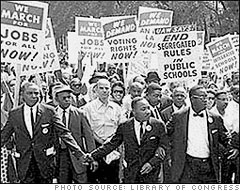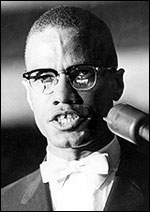Civil Rights Centenaries

2013 marks the (semi)centenaries of several major Civil Rights milestones
 March on Washington, Aug 28, 1963  Malcolm X Related Links |
From the Emancipation Proclamation in 1863 to the 1963 March on Washington, 2013 marks the anniversary of important milestones in the Civil Rights movement. Below is a look back at the pivotal moments in the movement that changed the course of history.
The Emancipation Proclamation
On January 1, 1863, the Emancipation Proclamation went into effect. Signed and issued by Abraham Lincoln, it declared free all slaves living in the confederate states, which were rebelling against the federal government at the time. The proclamation did not change the situation with the Confederacy. Confederate leaders criticized and ignored it. Slaves were freed slowly until 1865 when the Civil War ended and the 13th amendment, abolishing slavery, was ratified.
However, the long-term effect of the Emancipation Proclamation is undeniable. On its 50 year anniversary in 1913, writer W.E.B. Du Bios pointed out the changes it made in American society. "From slavery to freedom, from 4 million to 10 million, from denial of citizenship to enfranchisement, from being owned chattels to ownership of $600 million in property," he said.
Tensions Build in Birmingham
In 1963, many incidents brought the Civil Rights Movement in the United States to the forefront. On April 16, during anti-segregation protests, Martin Luther King, Jr., was arrested in Birmingham, Alabama. While jailed, he wrote his influential "Letter from Birmingham Jail." In it, he stated that it was an individual's moral duty to disobey unjust laws.
A month later, Commissioner of Public Safety Eugene "Bull" Connor unleashed police dogs and fire hoses on black activists during civil rights protests in Birmingham. Images of the brutality were televised and published around the world, helping the civil rights movement to gain international support.
March on Washington
On August 28, 1963, around 250,000 people participated in the March on Washington for Jobs and Freedom. It was the largest demonstration in the nation's capital and was the first to receive live international television coverage. Some protestors traveling from the South were harassed and threatened. The march ended at the Lincoln Memorial in a communal celebration. The event was peaceful and the heavy police presence turned out to be unnecessary. Bob Dylan, Joan Baez, Mahalia Jackson, and Marian Anderson were among the musicians who performed. Josephine Baker was the sole female speaker. She introduced the "Negro Women Fighters for Freedom," which included Rosa Parks. Martin Luther King, Jr., gave his "I Have a Dream" speech that day as well.
More Anniversaries
Major events in the Civil Rights movement continued throughout the rest of 1963. On September 15, violence returned to Birmingham, Alabama, when the 16th Street Baptist Church, a popular location for civil rights meetings, was bombed. Four young black girls were killed and 22 people were injured. The bombing caused riots to erupt in Birmingham. The riots led to the deaths of two other black youths. Two months later, Black Nationalist Malcolm X made his historic "Message to the Grass Roots" speech in Detroit, Michigan.
The year 2013 also marks the 100th anniversary of the birth of Rosa Parks. On January 21, 2013, the first African-American president of the United States, Barack Obama, will be inaugurated for a historic second term. Obama is also the first president since Abraham Lincoln to hang a copy of the Emancipation Proclamation in the Oval Office. One hundred fifty years later that document as well as other Civil Rights anniversary milestones serve as a reminder of how far we've come and the struggle many people have endured to get us here.







